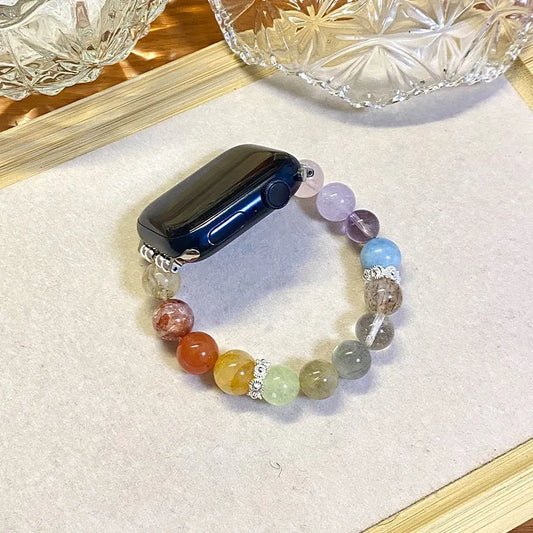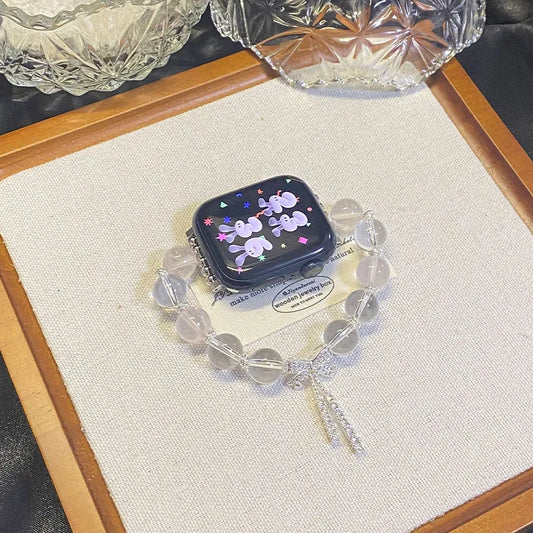When you buy an Apple Watch, it's only natural to wonder how much water it can handle.
Whether you're caught in the rain, washing your hands, or thinking about taking a swim, you might find yourself asking: Is my Apple Watch waterproof?

While the latest models are pretty impressive when it comes to water resistance, especially for swimming, there’s more to consider. The band you choose can make a big difference in how well your watch holds up in wet conditions.
In this guide, we’ll break down just how "waterproof" your Apple Watch really is and help you pick the best water-resistant bands for your lifestyle.
Waterproof vs. Water-Resistant: Do You Really Know the Difference?
Waterproof implies that an item is completely impervious to water.
In other words, it can withstand being submerged in water without sustaining any damage.
However, this term is often more idealistic than practical—very few consumer products, including watches, are genuinely waterproof.
On the other hand, water-resistant means that the item can resist the penetration of water to some degree but is not entirely impervious.
The level of resistance can vary significantly between products.
For example, an item labeled as "water-resistant" may be able to handle splashes or brief exposure to water, but prolonged immersion could cause damage.
Are Apple Watches Waterproof?
So, where does the Apple Watch fit in?

Most models come with a water resistance rating, typically specified in meters.
For instance, the Apple Watch SE and Series 10 are rated for water resistance up to 50 meters, making them suitable for shallow-water activities like swimming in a pool or ocean.
The Series 10 can even handle snorkeling up to 6 meters!
However, it's essential to note that these watches should not be used for scuba diving, waterskiing, or other high-velocity water activities.

Meanwhile, the Apple Watch Ultra 2 takes it a step further, boasting a water resistance rating of 100 meters.
This means it can withstand high-speed water sports and recreational scuba diving (up to 40 meters with a compatible third-party app).
However, it should not be used for diving below that depth.
One crucial point to remember is that water resistance isn't a permanent condition—it can diminish over time.
Regular exposure to water and other factors can affect your watch's protective capabilities.
For more information, see support.apple.com/HT205000
Water Challenges: What Everyday Situations Might Your Apple Watch Face?
1. Sudden Rain Showers:
Picture yourself out for a jog when dark clouds suddenly roll in. A downpour hits, but don’t panic! Most Apple Watch models can withstand a bit of rain.
However, it’s best to dry your watch afterward to maintain its longevity.
2. Swimming:
If you’re planning a day at the pool or a trip to the beach, the Apple Watch SE and Series 10 are designed for shallow-water activities. They’re rated for water resistance up to 50 meters, making them suitable for swimming.
Just be sure to rinse it with fresh water afterward to remove any chlorine or salt, which can be harsh on the watch.
3. Sauna Sessions:
Enjoying a sauna or steam room can be refreshing, but it’s wise to take your Apple Watch off. While it can tolerate some humidity, the extreme heat and moisture may affect its internal components over time. If you’re wondering whether it’s safe to bring your watch in, you can read more in this guide about wearing an Apple Watch in the sauna.
4. High-Moisture Professions:
If you work in a profession like nursing or cooking, your Apple Watch might frequently encounter water. It’s built to handle splashes, but make sure to clean off any soap or cleaning agents afterward, as these can accumulate and potentially damage the watch.
5. Workouts and Activities:
During your workouts, sweat is inevitable. The Apple Watch is designed to handle sweat and moisture, making it an excellent companion for exercise. Silicone and Nylon bands are particularly effective in managing sweat, whereas leather bands may not fare as well.
6. Everyday Life:
From washing dishes to catching a bit of water while rinsing your hands, your watch faces water daily. Many users wear their watch during these activities, but a little caution can protect it from unnecessary wear and tear.
Band Materials Uncovered: Which One Waterproof?
Are Silicone Apple Watch Bands Waterproof?
Silicone bands are highly water-resistant and perfect for active individuals. They are flexible, durable, and easy to clean, making them a favorite for workouts and swimming. These bands dry quickly, ensuring comfort even when wet.
Are Nylon Apple Watch Bands Waterproof?
Nylon bands feature a breathable design that allows for airflow while still providing decent water resistance. While they can handle splashes and sweat, they aren’t ideal for submersion. Quick-drying and lightweight, they suit casual water activities.
Are Stainless Steel Apple Watch Bands Waterproof?
Stainless steel bands offer a sleek and sophisticated look but are less water-resistant than silicone or nylon. They can handle occasional splashes, but prolonged exposure to water—especially saltwater—may cause corrosion. Rinse the band with fresh water after swimming to maintain its finish.
Are Titanium Apple Watch Bands Waterproof?
Titanium bands are incredibly strong and lightweight, offering a premium feel. They have a decent level of water resistance, but like stainless steel, they should not be exposed to water for long periods. Proper care is essential to prevent tarnishing.
Are Fabric Apple Watch Bands Waterproof?
Fabric bands can be comfortable and stylish, but they are generally less resistant to water. They may absorb moisture, which can lead to discomfort. If you choose a fabric band, be cautious around water to avoid sogginess and odors.
Are Ceramic Apple Watch Bands Waterproof?
Ceramic bands are elegant and scratch-resistant, offering a premium aesthetic. While they can handle splashes, it's best to avoid submerging them in water for long periods, as they can become damaged.
Are Carbon Fiber Apple Watch Bands Waterproof?
Carbon fiber bands are lightweight and strong, often offering a modern look. Their water resistance can vary, so check the specific brand’s recommendations for care and maintenance.
Are Leather Apple Watch Bands Waterproof?
Leather bands are classic and stylish but are not water-resistant. Exposure to water can damage the leather, causing it to warp or deteriorate. If you opt for leather, be sure to keep it dry to maintain its quality.
Are Resin Apple Watch Bands Waterproof?
Resin bands are lightweight and often come in vibrant colors. They can be resistant to water but may not hold up as well under prolonged exposure. Check the manufacturer's guidelines for specific care instructions.
Are Wooden Apple Watch Bands Waterproof?
Wooden bands offer a unique and eco-friendly aesthetic. However, wood is not water-resistant and can warp or crack if exposed to moisture. It’s best to avoid water exposure altogether with these bands.
Are Pearl and Gemstone Apple Watch Bands Waterproof?
These luxurious materials add a touch of elegance to your Apple Watch but are not practical for water exposure. They are more suited for special occasions and should be kept dry to avoid damage.
Check out our Waterproof Apple Watch Bands collection, designed to withstand everything from daily showers to intense workouts.
What to Do if Water Gets into Your Apple Watch
If you’ve ever found yourself swimming or taking a shower with your Apple Watch still on, you might be wondering what happens if some water gets inside.
Thankfully, your watch has a built-in feature to help with that!
To start, you’ll want to activate Water Lock.
This feature disables the touchscreen, so you don’t accidentally tap anything while in the water.
You can turn it on through the Control Center or it’ll automatically activate during a water workout, like swimming.
Here’s a quick guide on how to eject any water that may have seeped in:
- Press the side button to open the Control Center on your Apple Watch.

- Scroll down and tap the water drop icon to turn on Water Lock.
- Hold down the Digital Crown to eject the water.
You’ll see a little graphic, and your watch will make a beeping sound as it pushes out the water—this process takes just a few seconds. Once it’s done, Water Lock will turn off automatically, and you can go back to your day without a worry.
Caring for Your Apple Watch to Avoid Water Damage
To keep your Apple Watch in top condition and minimize water damage, follow these essential care tips:
- Rinse After Water Exposure: Rinse your watch with fresh water after swimming or exercising to remove chlorine or salt.
- Choose the Right Band: Opt for silicone or nylon bands for water activities. Avoid leather or fabric bands, as they can absorb moisture.
- Regular Cleaning: Clean your watch and band regularly with a soft, lint-free cloth and mild soap. Avoid harsh chemicals.
- Check for Damage: Periodically inspect your watch for scratches or damage to seals that could compromise water resistance.
- Avoid Extreme Conditions: Steer clear of extreme activities like scuba diving or waterskiing that may exceed the watch's water resistance limits.
- Dry It Thoroughly: After exposure to water, dry your watch thoroughly with a soft cloth to prevent moisture buildup.
- Store Properly: When not in use, store your watch in a cool, dry place to avoid humidity, and consider using its original box or a protective case.







